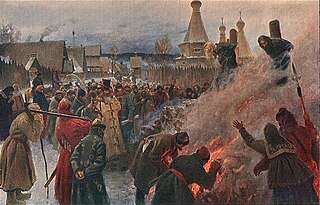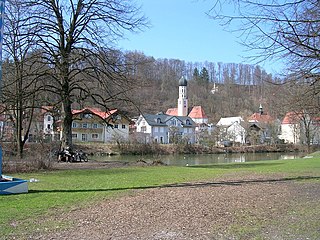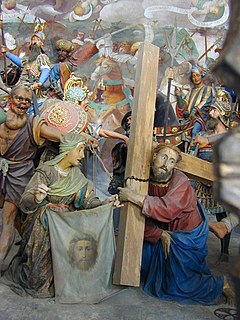
Death by burning is an execution and murder method involving combustion or exposure to extreme heat. It has a long history as a form of public capital punishment, and many societies have employed it as a punishment for and warning against crimes such as treason, heresy, and witchcraft. The best-known execution of this type is burning at the stake, where the condemned is bound to a large wooden stake and a fire lit beneath.

Death by sawing is the act of sawing or cutting a living person in half, either sagittally, or transversely. Death by sawing was a method of execution reportedly used in different parts of the world.

Elizabeth of Hungary, also known as Saint Elizabeth of Thuringia, or Saint Elisabeth of Thuringia, was a princess of the Kingdom of Hungary and the landgravine of Thuringia in Germany.

Hildegard, was a Frankish queen consort who was the second wife of Charlemagne and mother of Louis the Pious. Little is known about her life, because, like all women related to Charlemagne, she became notable only from a political background, recording her parentage, wedding, death, and her role as a mother.

Wolfratshausen is a town of the district of Bad Tölz-Wolfratshausen, located in Bavaria, Germany. The town had a population of 19,033 as of 31 December 2019.

Saint Alban is venerated as the first-recorded British Christian martyr, for which reason he is considered to be the British protomartyr. Along with fellow Saints Julius and Aaron, Alban is one of three named martyrs recorded at an early date from Roman Britain. He is traditionally believed to have been beheaded in Verulamium sometime during the 3rd or 4th century, and his cult has been celebrated there since ancient times.

Eulalia of Mérida was a young Roman Christian martyred in Augusta Emerita, the capital of Lusitania, during the Persecution of Christians under Diocletian. Other views place her death at the time of Trajan Decius. There is debate whether Saint Eulalia of Barcelona, whose story is similar, is the same person. Up till the proclamation of James, son of Zebedee, Eulalia was invoked as the protector of Christian troops in the Reconquista and was patron of the territories of Spain during their formation.

Saints Chrysanthus and Daria are saints of the Early Christian period. Their names appear in the Martyrologium Hieronymianum, an early martyrs list, and a church in their honour was built over their reputed grave in Rome.
Alban of Mainz was a Catholic priest, missionary, and martyr in the Late Roman Empire. He is venerated as Saint Alban of Mainz in the Catholic Church, not to be confused with Saint Alban of Verulamium.

Joseph of Freising, also known as Joseph of Verona, was Bishop of Freising from 747 or 748 until his death.
Robert Samuel was an English priest of East Bergholt in Suffolk, England who was imprisoned, tortured and burnt to death as a judicial execution under the Marian persecutions, and is commemorated as one of the Ipswich Martyrs. His sufferings are recorded in John Foxe's Book of Martyrs.
The Pappenheimer Case centered around a family who were tried and executed for witchcraft in 1600 in Munich, Bavaria, Germany. The family were executed, along with accomplices they were forced to name under torture, after a show trial as scapegoats for a number of unsolved crimes committed years back in a display of extreme torture intended to deter the public from crime. The witch trial resulted in the death of twelve people: four of the Pappenheimer family and two of their accused accomplices in the first trial, followed by the remaining member of the family and five other accomplices in the second trial. The trial was of one of the most well-publicized witch trials in German history.
John Evangelist Stadler was a Bavarian hagiographer.
Julius was a member of the Roman Senate. He is recorded by St. Eusebius and St. Pontian, as a martyr.

Adolf Clarenbach, burnt at the stake in Cologne, died as one of the first Protestant martyrs of the Reformation in the Lower Rhine region in Germany.

Wolfsindis of Reisbach is a regional saint of the Middle Ages in Lower Bavaria, who is revered as holy virgin and martyr. Her veneration dates back to the 7th or 8th century.

A calvary, also called calvary hill, Sacred Mount, or Sacred Mountain, is a type of Christian sacred place, built on the slopes of a hill, composed by a set of chapels, usually laid out in the form of a pilgrims' way. It is intended to represent the passion of Jesus Christ and takes its name after Calvary, the hill in Jerusalem where, according to tradition, Jesus was crucified.

Saint Theodore of Octodurum is the first known bishop of Octodurum, Alpes Poeninae province. He is the patron saint of Valais and of the Walser. His feast day is 16 or 26 August.

Arnold of Arnoldsweiler (died c. 800 in Ginnizweiler, today Düren-Arnoldsweiler) is a saint of the Roman Catholic Church, Orthodox Church and True Orthodox Church and was a musician at the court of Emperor Charles the Great, known as Charlemagne. His feast day is 18 July.

Saint Nemesion was an Egyptian martyr in Alexandria, Egypt during the persecutions of Christians by the Roman emperor Decius. A group of other Christians were martyred at the same time. His feast day is 19 December, or 10 September in some calendars.
















